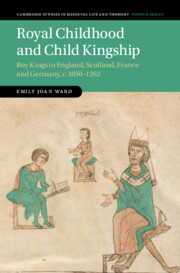Book contents
- Royal Childhood and Child Kingship
- Cambridge Studies in Medieval Life and Thought
- Royal Childhood and Child Kingship
- Copyright page
- Dedication
- Contents
- Figures
- Preface and Acknowledgements
- Abbreviations
- Genealogies
- Chapter 1 Royal Childhood and Child Kingship
- Part I Royal Childhood and Child Kingship: Models and History
- Chapter 2 Children and Kingship in the Early and Central Middle Ages
- Chapter 3 Woe to Thee, O Land? Models of Child Kingship
- Part II Royal Childhood: Preparation for the Throne
- Part III Child Kingship: Guardianship and Royal Rule
- Bibliography
- Index
Chapter 2 - Children and Kingship in the Early and Central Middle Ages
from Part I - Royal Childhood and Child Kingship: Models and History
Published online by Cambridge University Press: 04 August 2022
- Royal Childhood and Child Kingship
- Cambridge Studies in Medieval Life and Thought
- Royal Childhood and Child Kingship
- Copyright page
- Dedication
- Contents
- Figures
- Preface and Acknowledgements
- Abbreviations
- Genealogies
- Chapter 1 Royal Childhood and Child Kingship
- Part I Royal Childhood and Child Kingship: Models and History
- Chapter 2 Children and Kingship in the Early and Central Middle Ages
- Chapter 3 Woe to Thee, O Land? Models of Child Kingship
- Part II Royal Childhood: Preparation for the Throne
- Part III Child Kingship: Guardianship and Royal Rule
- Bibliography
- Index
Summary
The intersection of childhood and rulership has a long history. This chapter compares examples of child kingship across Europe before 1050 with cases between the eleventh and thirteenth centuries. It illustrates how structural developments in society, culture, politics and law brought greater political stability to a child’s rule during the central Middle Ages. Over this period, cultural attitudes towards violence were changing, practices of succession and inheritance were evolving, and ideas around marriage, illegitimacy and queenship were shifting. Such developments fundamentally altered the court environments into which royal children were born, the political context within which they succeeded, and the practicalities and precarities of their early experiences of rulership. This chapter examines aspects of violence, succession and queenship in turn before, in the fourth and final section, arguing for the need to revise claims of Germany’s exceptional ‘rejection’ of child kingship. While there are meaningful differences in how children were incorporated within systems and practices of kingship, this chapter suggests divergences between kingdoms should not be exaggerated.
Keywords
- Type
- Chapter
- Information
- Royal Childhood and Child KingshipBoy Kings in England, Scotland, France and Germany, c. 1050–1262, pp. 33 - 52Publisher: Cambridge University PressPrint publication year: 2022

